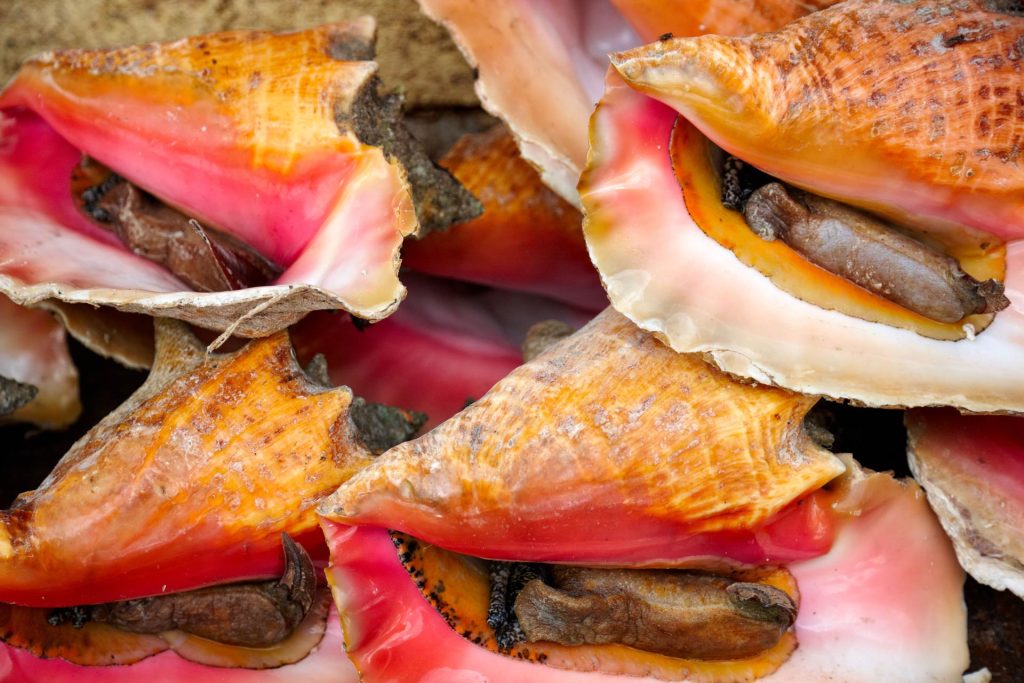Matthew Robinson — aka Jamaica Food Boss on YouTube — makes vlogs about popular dishes in Jamaica and other parts of the Caribbean. In a trio of videos, he introduced viewers to the signature food in The Bahamas: conch, a sea snail whose distinct spiral shell is synonymous with the Caribbean, decorating many a mantel as a souvenir from visiting the region.
“Dice it up into small, fine pieces so that each time you get a bite of the salad you’re getting a piece of conch in it,” Robinson explains, narrating the actions of the fleet-handed chef, who deftly chops the white flesh of the creature that was so freshly out of the sea it was still moving as he picked it up.
“I’m really excited for this. This is one of my favourite meals,” said Robinson. He bought a “regular” salad with tomatoes, onions and green pepper, and a “tropical” salad that also included chopped mango and pineapple.
The chef offered him a long, thin tube. Jiggling, it looked like a translucent worm. Robinson explained that it was part of the conch’s intestines and considered an aphrodisiac, called pistol or Bahamian Viagra. Robinson put his head back and slid the tube down his throat.
“Not much flavour,” he reported. “This is something that The Bahamas is known for. And that you must have when you try here, is what I heard.”
On video, Robinson tried other popular conch dishes: conch fritters and cracked conch. The latter, dipped in batter and deep fried, looked like chicken nuggets. “It’s something very addictive, similar to the name,” said Robinson.
Conch, queen conch to be exact, is an integral part of the Bahamian cultural identity. The shell — faded orange on the outside and pearly pink on the inside — is at the crest of the country’s coat of arms. Online lists of must-try Bahamian foods include multiple conch dishes. Thousands of Bahamians make their living directly or indirectly from conch and other seafood.
“There is no Bahamas without conch,” said Lindy Knowles, senior science officer with conservation NGO Bahamas National Trust, in an Associated Press article last year about the decline of queen conch numbers in Bahamian waters.
Other articles have been published over the years warning about the risk facing the species. Now it’s gotten to the point where experts estimate queen conch is unlikely to be a viable industry in as little as six years.
The problem is overfishing, and it’s been affecting many species that are important to the diet and culture of the region. Overfishing doesn’t just remove too many adult fish, but too many young fish that haven’t yet reproduced, leading to overall population declines. As a result, Caribbean governments and NGOs have been taking steps to protect animals whose loss could strike at the heart of the Caribbean society and economy.
The Nassau grouper, named after The Bahamas’ capital, is used to make grouper fingers. It involves cutting the fish into thin strips, coating it with batter, and deep frying it. But the International Union for Conservation of Nature (IUCN) has listed the fish as critically endangered.
Meanwhile, the spiny lobster or crawfish — which lacks large claws and is prized mainly for its tail — is The Bahamas’ top seafood export, with the industry valued at US$90 million.
In Jamaica, red snapper is preferred to make the distinctive escovitch fish. The fish is coated in allspice and other seasoning, fried, then soaked in a pickled sauce made with various vegetables, including sweet peppers and onions.
Parrotfish can substitute. But both parrotfish and snapper, along with grouper, are of concern to environmental watchdogs, as they’re all important to the maintenance of coral reefs — a major tourist draw that is also being decimated by human activity.
In Trinidad & Tobago, bake and shark is legendary. A large round, fried bake stuffed with fried slices of shark meat and covered with various toppings and condiments, most enjoy it at Maracas beach on Trinidad’s north coast.
Similarly in Bermuda, the traditional shark hash is made by sauteing shredded shark meat in shark liver oil along with onions, pepper, and other seasonings.
But many shark species are listed as vulnerable or endangered. Sharks are apex predators, so the reduction in their numbers destabilises the entire marine ecosystem and harms many other Caribbean fish stocks, including the ones already mentioned in this story.
The region’s greatest challenge is illegal, unreported, and unregulated (IUU) fishing, explained Natalie Miaoulis-Maillis of the Nature Conservancy, a United States-based NGO that operates all over the world. She was speaking on their online programme, Caribbean Currents.
“IUU fishing is one of the greatest threats to sustainability of our fisheries in the region. Because we have a lack of capacity or resources to enforce our rules and regulations for fishing, this leads to a lot of illegal activity,” she explained. “Entities from other countries are coming into our countries and breaking our laws and illegally fishing and harvesting, which puts more pressure on our resources.”
Of course local fishers contribute to overfishing as well. Miaoulis-Maillis compares it to using a bank account without keeping track of how much money is taken from and left in the account.
“If we don’t know how many fishers are participating in a fishery, how many are dependent, and also how much are we removing from our ocean, then we really don’t know how to properly manage our fisheries,” she said. “This is a big problem for our region in comparison to other countries that have very good data collection and recording mechanisms.”
Some of the steps the region has taken to save their fisheries include marine managed/protected areas or sanctuaries, which allow law enforcement to focus their limited resources on areas key to species reproduction or that contain nurseries; total or seasonal bans (the latter coinciding with breeding schedules); the banning of certain practices like spear fishing or the use of small mesh nets; and requiring that captured fish be a certain size to prevent the removal of juvenile fish.
Jamaica has 18 sanctuaries, including Pedro Bank, where the bulk of the island’s queen conch population is found. After a two-year total ban on conch fishing, a five-month seasonal ban was instituted in 2021. A catch limit has been imposed of 300 tonnes for large boats, and 50 for artisans.
A sign that these efforts are seeing some success is that the Jamaican Conch Cluster — an amalgamation of companies that markets the majority of Jamaican conch — has been certified by the Marine Stewardship Council (MSC), an NGO that assesses the sustainability of fisheries. It’s something that will be put on labels. It makes seafood more appealing to discerning customers.
The Bahamas’ spiny lobster fishery has also been certified by the MSC. And president of the Bahamas Commercial Fishers Alliance Adrian LaRoda told the Nassau Guardian that 2024 is “a bumper year for spiny lobster fishermen”, and attributed it to a decrease in poaching.
The Bahamas has sanctuaries that are policed by a Marine Action Partnership between the Bahamas Department of Marine Resources, the Ministry of Agriculture & Marine Resources, the Ministry of National Security, the Royal Bahamas Police Force, Customs, Immigration, the Royal Bahamas Defence Force, the National Fishers Association, and other fishing organisations.
Using similar measures, the Cayman Islands has saved their depleted Nassau grouper fishery. And the successes give hope to still struggling fisheries — including the spiny lobster in Bermuda. The government there has imposed catch limits and a seasonal ban, and is also introducing regulations to protect the shark population.
Considering the importance of the fishing industry, failure is not an option. “If we want sustainable oceans, if we want healthy communities, we need to always look at how we can improve our fisheries management,” said Natalie Miaoulis-Maillis. “Because it is such a critical cornerstone to the sustainability of our region.”
Foodie resolutions
As the new year approaches, it’s a great time to re-commit to sustainable food choices to help protect our marine environment for generations to come. Here’s a handy seafood guide:
- Sustainable: carite, flying fish, lionfish, mahi-mahi, squid, wahoo
- Much less sustainable: Atlantic cro cro/croaker, conch (especially if not farmed), jack (unless caught by handline), kingfish, lobster (avoid if less than 4”), tuna (unless line caught)
- Unsustainable: grouper, marlin, parrotfish, shark, shrimp, snapper, swordfish.

